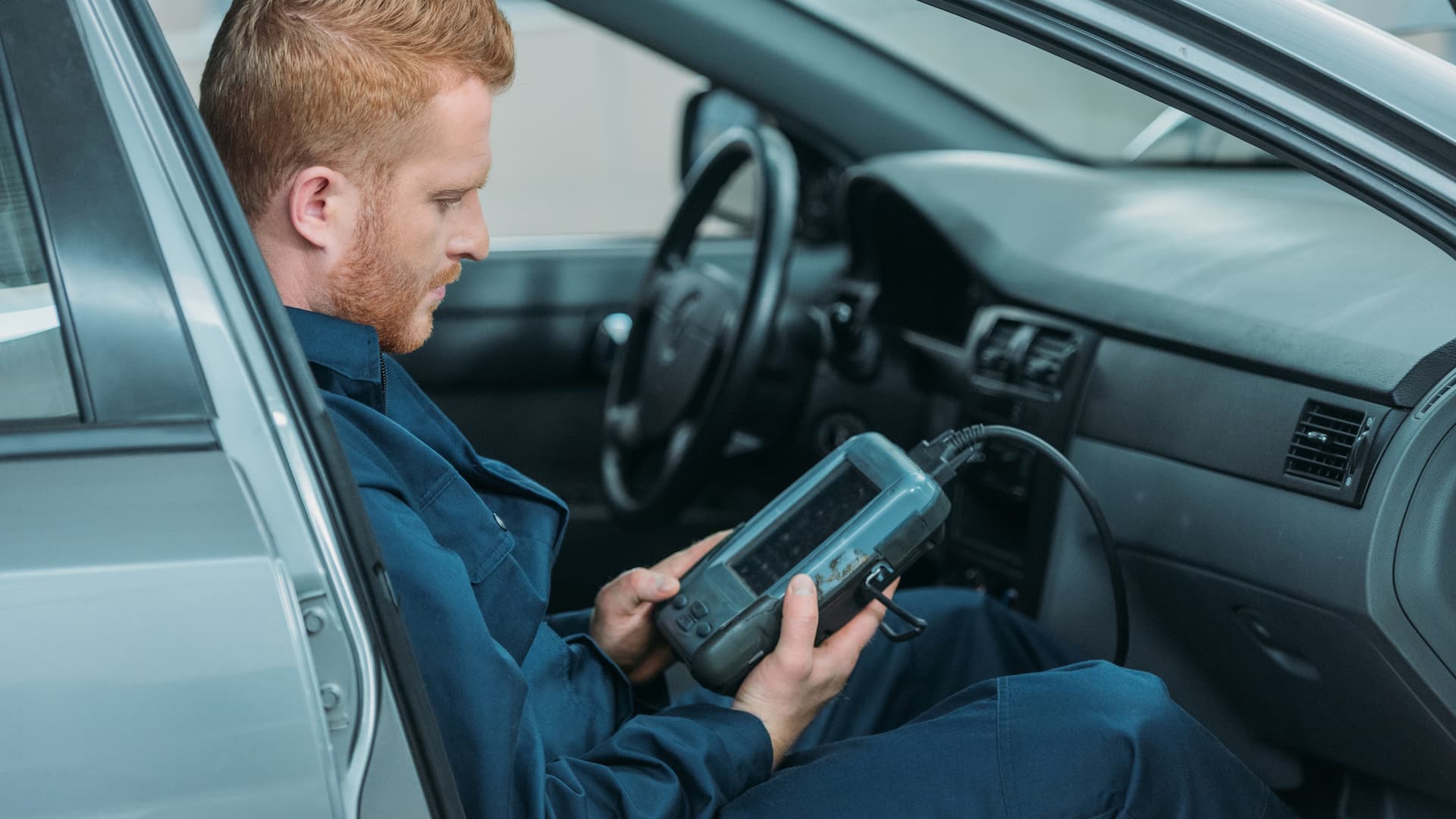Need help with your Brake Fluid Flush?
Our mobile mechanics bring the shop to you 7 days a week.

Find Your Cost
Why AutoNation Mobile Service?
We perform over 600 repair and maintenance services including oil changes, brakes, diagnostics, belts and hoses, and more. The best part? We come to you with all the necessary tools and parts.
 Upfront Pricing
Upfront Pricing
 Online Booking
Online Booking
 Quality Service
Quality Service
 Full Warranty
Full Warranty
Learn More About A Brake System Flush:
When Do I Need A Brake System Flush?
For car maintenance, it’s recommended you get a brake fluid flush every two years or 30,000 miles, depending on your driving and braking patterns. This’ll prevent a deeper, more expensive brake system repair — like total brake failure.
However, you’ll also need a brake system flush when certain symptoms show up, like:
1. Brake Pedal Feels Spongy Or Soft
Over time, moisture will accumulate in the brake fluid (a hydraulic fluid), resulting in a spongy or soft feel when you press the brake pedal.
You may also notice that you need to push the brake pedal entirely to the bottom before it slows and stops your car. This indicates you need a brake fluid change.
2. Poor Brake Performance
Poor brake performance can signify contaminated or bad brake fluid, which requires a brake flush.
However, it can also mean something else if the brake system is struggling, such as brake caliper, brake pad, or brake rotor issues. Bad braking efficiency can also happen due to an underlying problem, like damaged tire tread, shocks, or struts.
So it’s best to get your brake system components inspected by a certified technician. Only they can tell if you need a brake job or another repair service to rectify your car’s brake performance.
3. Change In Brake Fluid Color
Inspect the brake fluid to see if it’s brown, black, or sludgy. If so, it’s time for a brake fluid flush service.
4. ABS Dashboard Light Turns On
The ABS dashboard light indicates a problem with your anti-lock braking system. This system prevents your wheels from locking up to avert skids and maintains traction during braking.
And if your car has low brake fluid (which may translate to poor braking performance), it’ll automatically turn on the ABS system to allow safe braking.
5. Strange Noises or Smells During Braking
If you hear strange sounds when braking, it could be due to low brake fluid or a different brake system issue. Common strange sounds include scraping or grinding noises.
Burning smells after braking can also indicate that you’ve burnt out the brake fluid. In such a case, you need a brake flush because driving with burnt brake fluid can lead to other major brake issues, including total brake failure.
6. Brake Fluid Leak
You probably need an immediate brake fluid flush if you detect a brake fluid leak.
A brake fluid leak hampers the braking efficiency since the force transmitted through the brake line is reduced.
To check the brake fluid level, take a look at the brake fluid reservoir located in your engine bay. If you can’t find the brake fluid reservoir, check your owner’s manual for help and other related data.
How Much Does It Cost To Replace Brake Fluid?
A brake fluid flush or old fluid replacement can cost you about $90-$200.
The cost typically depends on your choice of new brake fluid and your area’s auto repair or brake service labor charges. Other things that can influence the cost include your car’s model, engine, and make.
How Urgent Is A Brake System Flush?
The entire brake system is very important, including the brake fluid. Unlike oil changes, flushing brake fluid is often ignored.
Now, if you don’t get a fluid flush done when you need to, the fluid will decrease braking efficiency while breaking down and corroding the braking system components.
So it’s important to immediately get a brake flush to remove contaminated, old brake fluid and replace it with new fluid.
Tip: You can set a car maintenance schedule for regular auto repair and brake inspection.
5 Brake System Flush FAQs
Here are some answers to FAQs on the brake system and brake fluid exchange:
1. What Is A Brake System Flush?
Like most fluids in your car, the brake fluid needs to be replaced eventually, usually as a precautionary measure.
Why?
Brake fluid can degrade by picking up dirt, metal, rubber debris, etc., over time.
To ensure your brake system has healthy and fresh brake fluid, a certified technician will conduct a brake system flush. This process basically removes all the old fluid from each brake line and replaces it with new, fresh fluid.
2. What Happens During A Brake Fluid Flush?
It’s best to take your car to an auto repair shop or a dealership or contact a mobile certified technician to come over to your location for brake service.
During a brake fluid flush service, your certified technician or mechanic will:
- Find the brake fluid reservoir
- Drain out the contaminated, old brake fluid (helps remove air bubbles from the braking system too)
- Clean out the debris left in the braking system
- Check if the brake caliper, brake pad, brake rotor, brake pedal, or any other brake component needs replacing
- Replace your brake fluid with high-quality, new fluid (clean fluid)
- Remove the air trapped in each brake line with a bleeder
- Finally, do a proper brake inspection to check if the brake system is working right
3. Why Is A Brake Fluid Flush Necessary?
Your brake system is important for your safety. So if it isn’t in the best condition, you may compromise several working automotive or brake parts.
Many of these automotive parts are linked together using brake lines and hoses that use brake fluid to transmit and amplify forces. That’s why it’s necessary to maintain clean fluid to avoid hampering the functioning of any brake component.
A brake fluid flush service is also necessary to prevent moisture build-up. It can cause corrosion of metal brake parts like brake calipers, brake rotors, the master cylinder, etc., compromising the entire braking system.
A simple brake fluid exchange should prevent this corrosion of brake parts.
4. Why Does Brake Fluid Wear Out?
Brake fluid, a hydraulic fluid, is hygroscopic by its chemical design — meaning it absorbs moisture easily.
This is bad news for your brake system components as the master cylinder, brake lines, proportioning valves, ABS, and calipers are all made of aluminum or steel — metals that corrode due to moisture.
So, at any point the brake system is exposed to air (typically from the master cylinder reservoir), the brake fluid absorbs moisture. Eventually, the healthy, fresh fluid turns rusty brown or black due to corrosion inside the brake system.
As the fluid moisture increases, the brake fluid boiling point decreases, further reducing the efficiency of the bad brake fluid.
Note: Bad brake fluid is a common reason why the brake caliper and wheel cylinder start to seize.
5. What Does Brake Fluid Do?
When hitting the brake pedal, a plunger pushes against the master cylinder, transmitting fluid via the connected hoses to the brakes.
If you have a disc brake, fluid is pushed into a brake caliper. The brake caliper then presses a piston, squeezing the brake pad against the brake disc forcing your car’s wheel to slow or stop.
If you have drum brakes, the fluid is forced into the wheel cylinder, pushing the vehicle’s brake shoes against the drum to slow down or stop the wheel.
In both cases, brake fluid is integral in establishing effective communication between the brake pedal and the car’s brakes.
Related Repairs
Not sure? Let us diagnose
Other Repairs
We're here to keep you moving
Our experienced mobile mechanics are ready to help.
Get a Quote12-Month | 12,000-Mile Warranty


